A data driven fault diagnosis approach for robotic cutting tools in smart manufacturing
IF 6.5
2区 计算机科学
Q1 AUTOMATION & CONTROL SYSTEMS
引用次数: 0
Abstract
In smart manufacturing within Industry 4.0, tool condition monitoring (TCM) is used to improve productivity and machine availability by leveraging advanced sensors and computational intelligence to prevent tool damage. This paper develops a hybrid methodology using heterogeneous sensor measurements for monitoring robotic cutting tools with four tool states: healthy, surface damage, flake damage and broken tooth. The proposed approach integrates the maximal overlap discrete wavelet packet transform (MODWPT) with health indicators to construct feature matrices for each tool state. Feature selection is performed using the tree growth algorithm (TGA) to reduce computation time and improve feature space separation by selecting only relevant features. The selected features are input into a Gaussian mixture model (GMM) to detect, identify and classify each tool state with high accuracy. The proposed method provides a classification accuracy of 99.04 % for vibration, 95.51 % for torque, and 91.67 % for force signals. Using unseen vibration data, the model achieved a test accuracy of 98.44 %, demonstrating a high degree of generalizability. Comparative analysis demonstrates that our proposed approach provides superior feature discrimination and model stability, balancing computational efficiency and classification accuracy, validating the TGA-GMM framework as an effective solution for tool fault diagnosis in noisy, high-dimensional data.
基于数据驱动的智能制造机器人刀具故障诊断方法。
在工业4.0的智能制造中,工具状态监测(TCM)通过利用先进的传感器和计算智能来防止工具损坏,从而提高生产率和机器可用性。本文开发了一种使用异构传感器测量的混合方法,用于监测具有四种刀具状态的机器人刀具:健康,表面损伤,片状损伤和断齿。该方法将最大重叠离散小波包变换(MODWPT)与健康指标相结合,构建工具状态的特征矩阵。使用树生长算法(TGA)进行特征选择,通过只选择相关特征来减少计算时间和改善特征空间分离。将选择的特征输入到高斯混合模型(GMM)中,以高精度地检测、识别和分类每种工具状态。该方法对振动信号的分类准确率为99.04 %,对扭矩信号的分类准确率为95.51 %,对力信号的分类准确率为91.67 %。使用未见过的振动数据,该模型的测试精度达到98.44 %,显示出高度的泛化性。对比分析表明,该方法具有较好的特征识别和模型稳定性,平衡了计算效率和分类精度,验证了TGA-GMM框架是一种有效的工具故障诊断解决方案。
本文章由计算机程序翻译,如有差异,请以英文原文为准。
求助全文
约1分钟内获得全文
求助全文
来源期刊

ISA transactions
工程技术-工程:综合
CiteScore
11.70
自引率
12.30%
发文量
824
审稿时长
4.4 months
期刊介绍:
ISA Transactions serves as a platform for showcasing advancements in measurement and automation, catering to both industrial practitioners and applied researchers. It covers a wide array of topics within measurement, including sensors, signal processing, data analysis, and fault detection, supported by techniques such as artificial intelligence and communication systems. Automation topics encompass control strategies, modelling, system reliability, and maintenance, alongside optimization and human-machine interaction. The journal targets research and development professionals in control systems, process instrumentation, and automation from academia and industry.
 求助内容:
求助内容: 应助结果提醒方式:
应助结果提醒方式:


